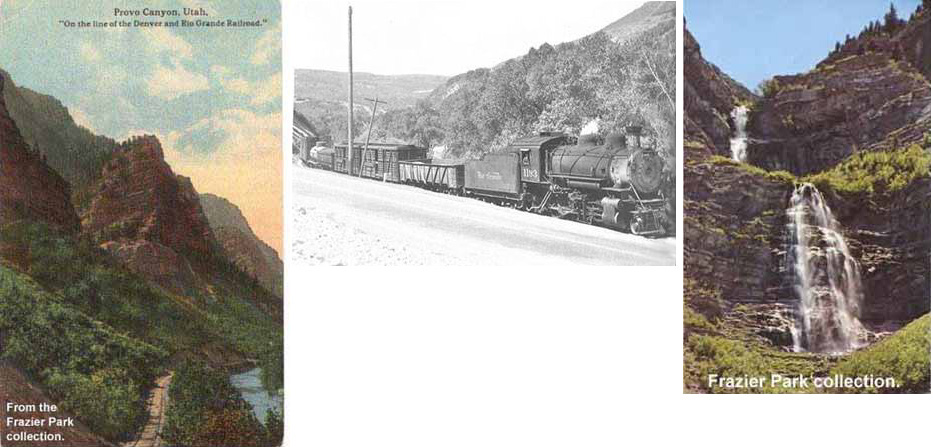
The historical information and photos are from the web site
of the Rio Grande Chapter of the National Railway Historical Society, Box
3381, Grand Junction, CO 81502.
Video of the Actual
Uintah Railway
The narrow gauge Uintah Railway was located in the Uintah Mountains
of Utah/Colorado and was built to haul gilsonite from the mines at Dragon,
Utah to a rail link with the Rio Grande Western Railway (later the D&RGW)
at Mack, Colorado. It was completed in 1905 and ceased operations in 1939.
Gilsonite is a brittle black asphaltic mineral resembling black glass that
was used as an additive for paint and insulating compounds. The gilsonite
was stacked in hundred-plus pound sacks on open flat cars.
The railroad hauled more than gilsonite, though, boasting two combination
baggage-passenger coaches, three former Pullman sleepers, 12 livestock
cars, 24 gondolas, 18 boxcars, and 71 flat cars. They owned eleven engines,
two of them 2-6-6-2T Mallets (shown in photos above).
The Uintah Railway was 63 miles long and was mostly grade; the only
level spot was at Mack. Out of Atchee the railroad climbed over 2,000 feet
in six miles to 8,437 foot Baxter Pass and then dropped down the other
side 1,500 feet in seven miles. From there, for 12 miles to the end of
the line at Dragon, the tracks crossed 37 bridges. One five mile stretch
consisted of a constant 7-1/2 percent grade through a series of curves
and hairpin turns, the sharpest of which was 66 degrees.
The G gauge Wasatch Mountain Railway is also mostly grade and at 7.2%
it is close to the Uintah's 7.5%. Much of it is on trestles and the 8 foot
diameter curves at the ends are close to the Uintah's 66 degree (9 foot
scale diameter) curves. It has a similar rolling stock roster and one locomotive
is a model of the Uintah Railway Mallet.
The Rio Grande Railroad
The Utah Eastern Railway (a subsidiary of the Rio Grande Western)
completed its standard gauge branch line up Provo Canyon (from Provo to
Heber City, Utah) in 1899. In 1921, the Denver & Rio Grande Western
Railroad (the D&RGW) took over the Rio Grande Western
and operated the branch until 1967. It lay dormant until 1970 when it was
purchased by the Wasatch Mountain Railway.
Within a short time after its completion, there was enough traffic on
the Provo Canyon Branch to warrant two mixed trains (a string of freight
cars plus a passenger car on the rear) each day. The line was mainly used
to ship general freight, livestock and agricultural products. During the
1930’s, more sheep were shipped from the Heber depot than from any
other rail station in the nation. My father, an engineer for the D&RGW,
told me that one night in the 1940s he spent an entire 16 hour shift loading
sheep on the branch.

From left: Rio Grande Railroad postcard from 1910; Heber
Creeper 1948; recent photo of Bridal Veil Falls; all from (no-longer-active
http://www.frazierparkutah.com/HomeFrameset.htm)
The Modern Day Wasatch Mountain Railway
The G gauge Wasatch Mountain Railway was named for the full size
Wasatch Mountain Railway founded in 1970 by a group of Heber Valley,
Utah, businessmen and some rail enthusiasts. They purchased 19.3 out of
the 28 miles of the dormant Provo Canyon Branch from the D&RGW Railroad
and operated their first train in July 1971. Later, the track became the
property of the Heber Valley Railroad and the Wasatch Mountain
Railway operated the trains. History
of the Wasatch Mountain Railway & Heber Creeper by Don Strack
The Wasatch Mountain Railway was named for the Wasatch Mountains
location of the Provo Canyon Branch Line, just as the Uintah Railway was
named after its home in the Uintah Mountains. The Wasatch Mountains
are west of the Uintahs and both are sub-ranges of the Rockies.
Heber Valley Railroad
The Heber Valley Railroad originally ran from Heber City to Bridal
Veil Falls (see photo above). But a massive snow slide in February 1996
wiped out the tracks and facilities at the falls, so the train started
running only as far as Vivian Park, two miles short of the falls. The tracks
between Vivian Park and Bridal Veil Falls have since been removed.
The early days Rio Grande mixed trains (they carried freight as well
as passengers) crept along the curving canyon track and up the 4% grade
of the Provo Canyon Branch so slowly that passengers took to calling it
the “Creeper” or the “Heber Creeper.” The name was
adopted by the Heber Valley Railroad for its excursion train, a
popular tourist attraction in Utah. The Heber Valley Railroad tracks
run near the Sundance ski resort and the train was used during the Utah
Winter Olympics to carry passengers to the cross country ski competitions
at Soldier Hollow in Heber Valley.

Recent photos of the Heber Creeper. Photos from: http://www.travel-wise.com/northamerica/heber/index.html



